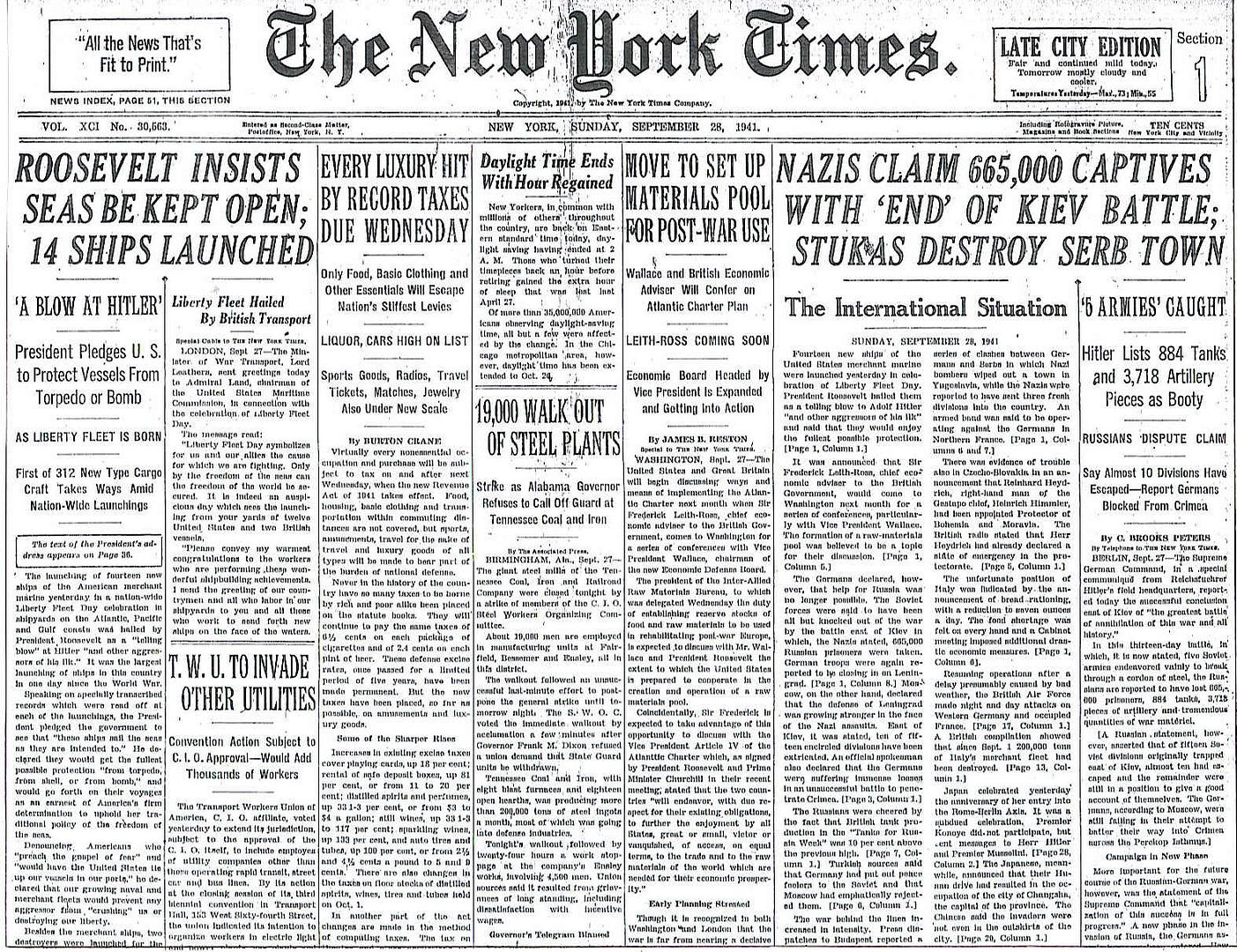
Posted on 09/28/2011 4:34:51 AM PDT by Homer_J_Simpson

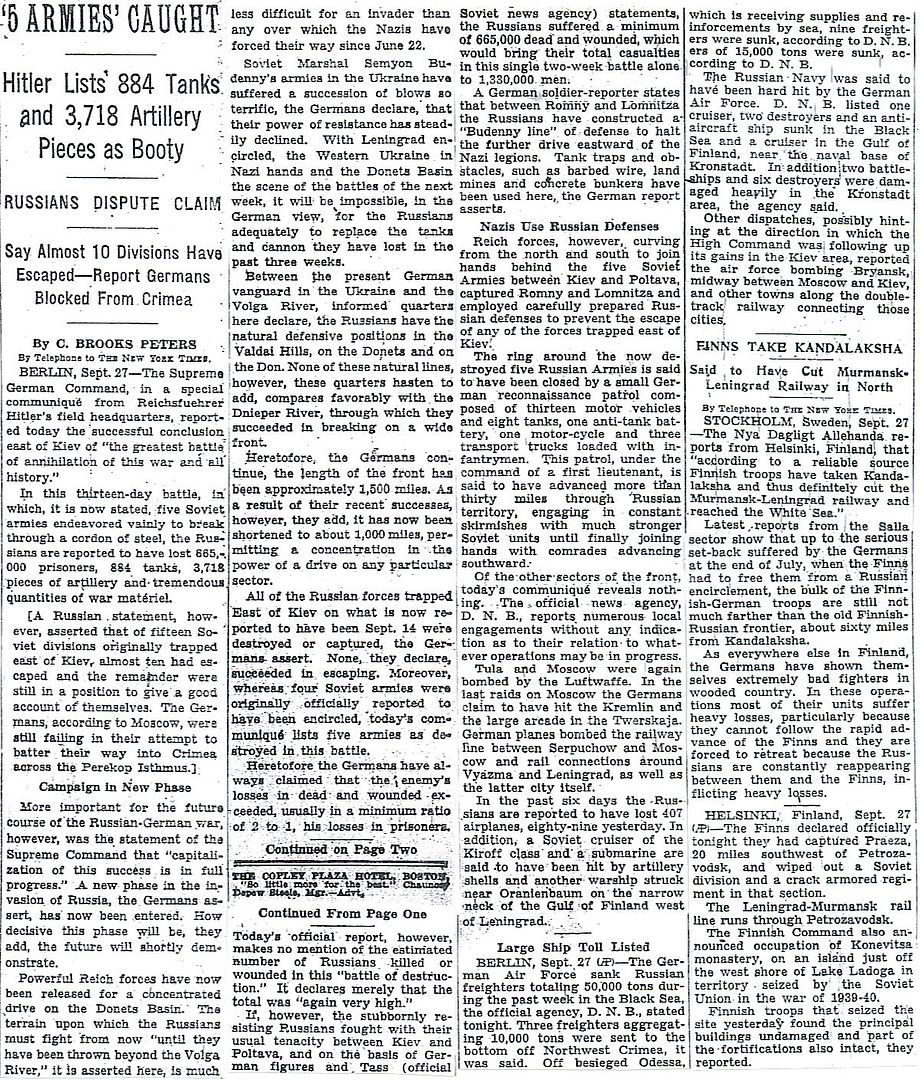
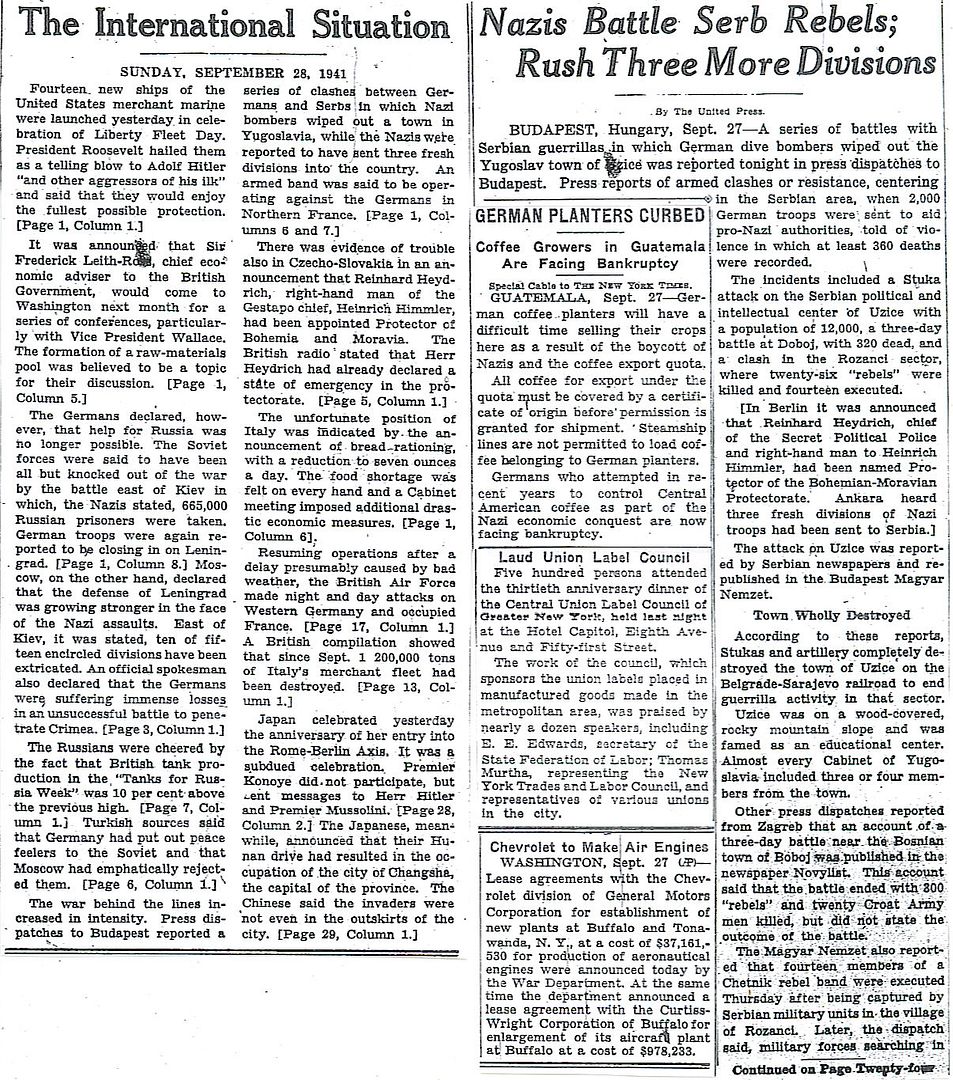
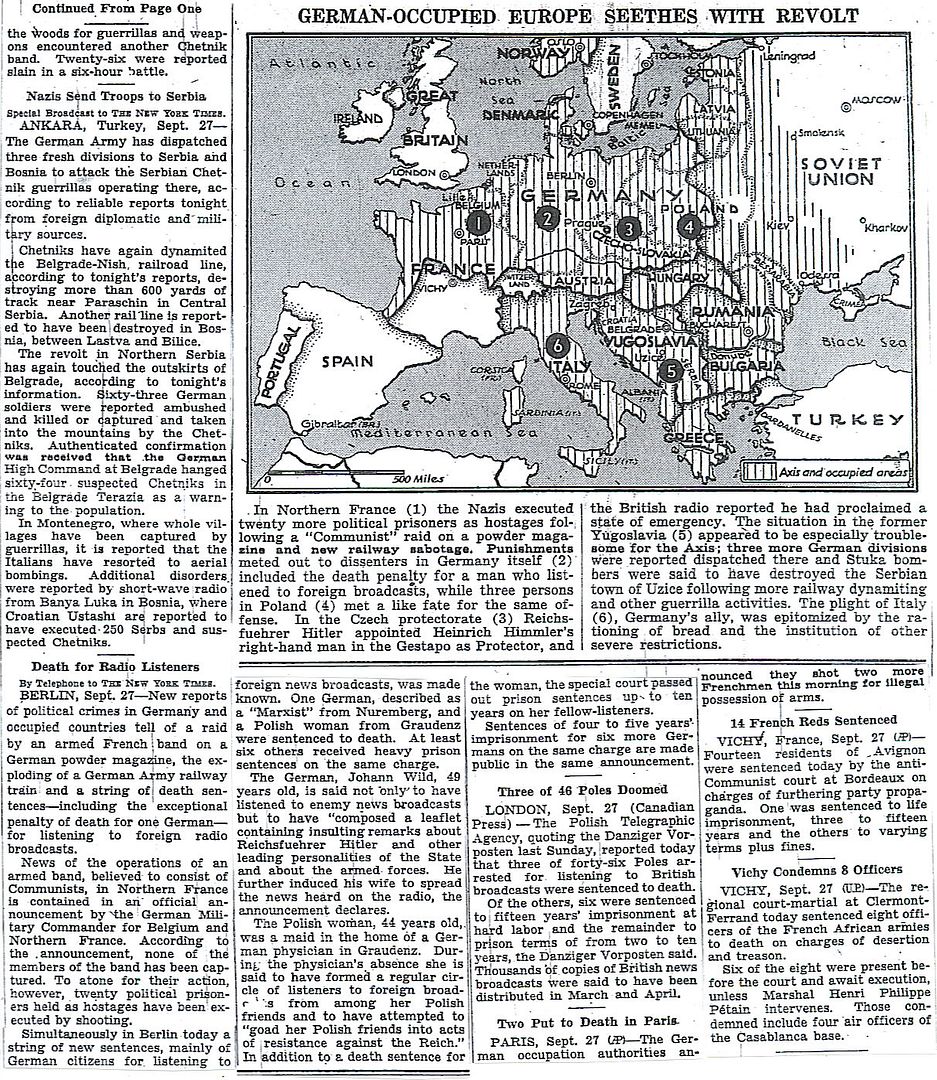
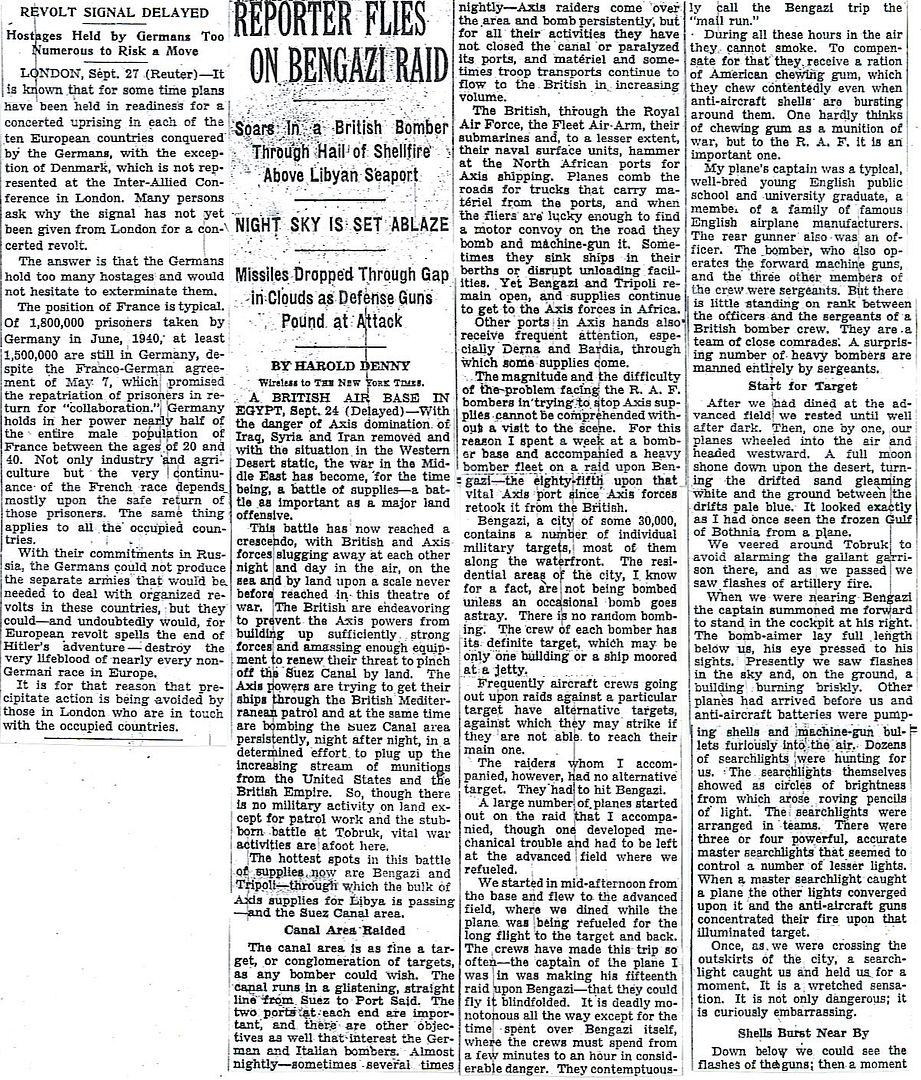
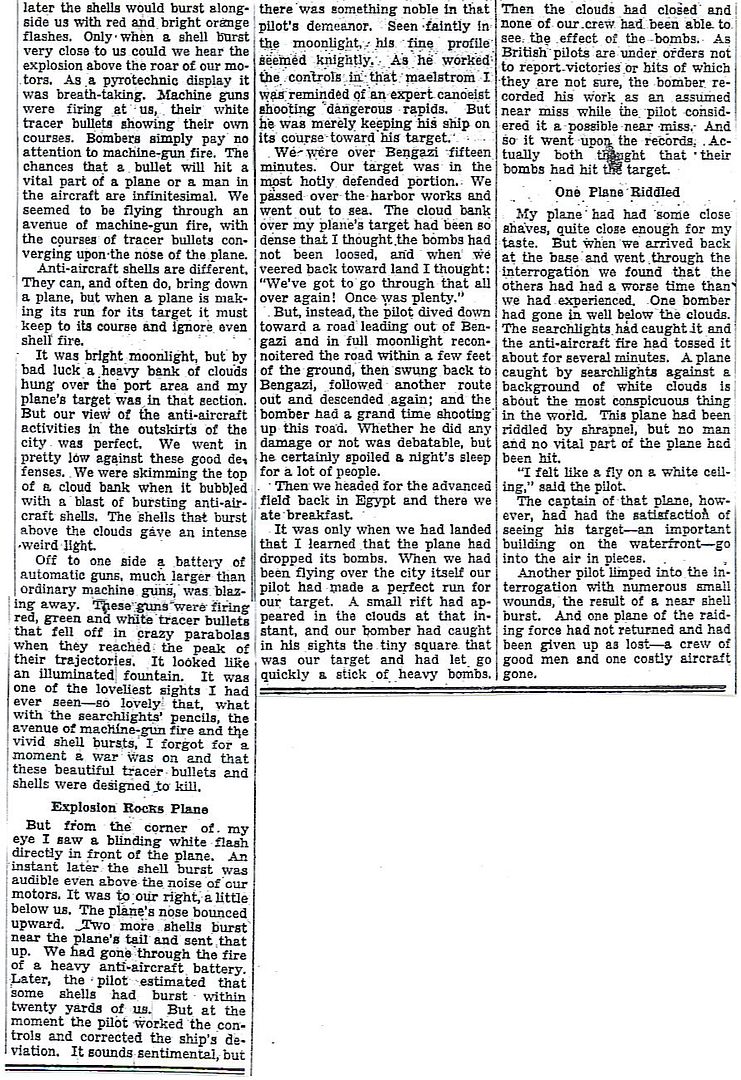
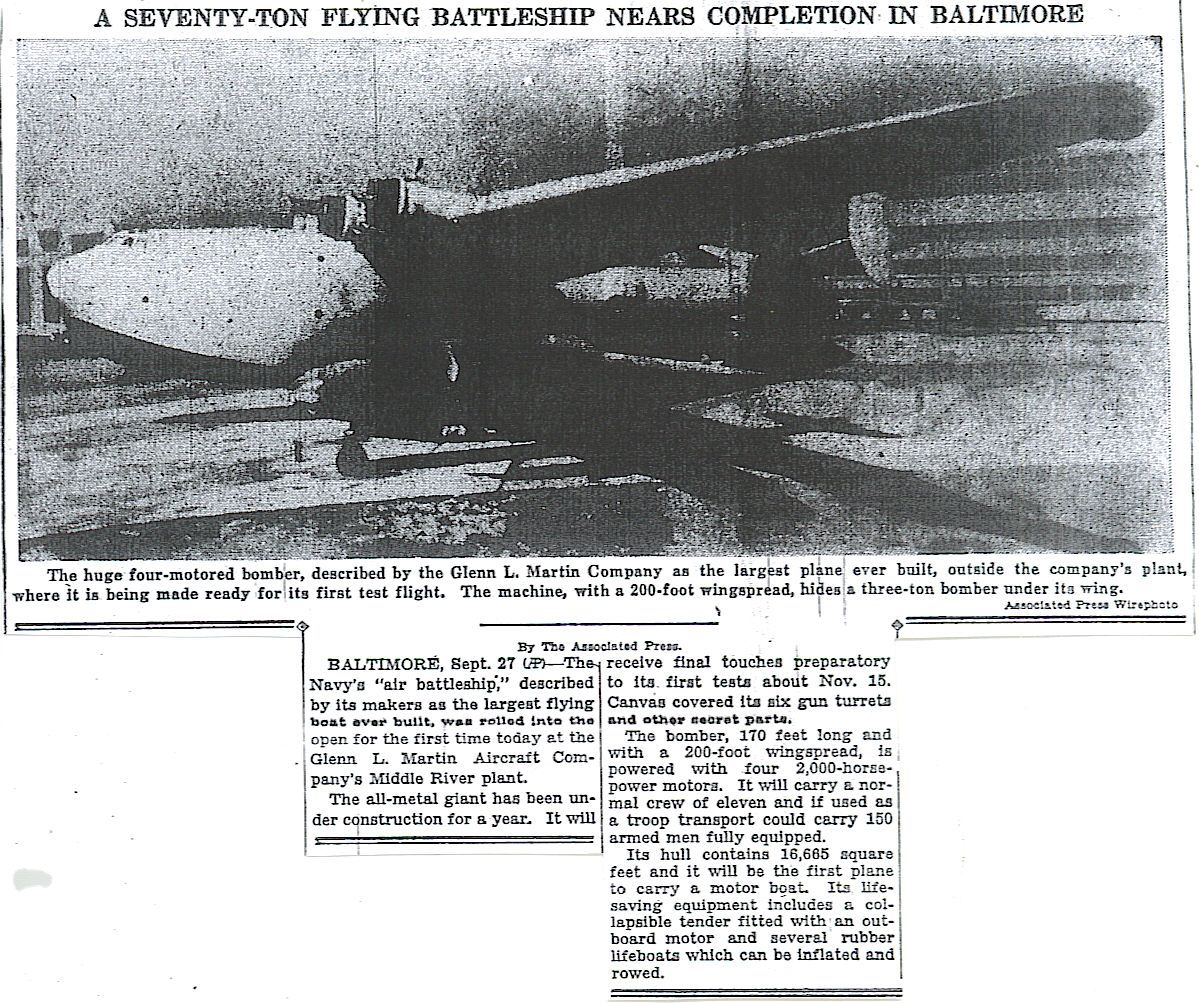
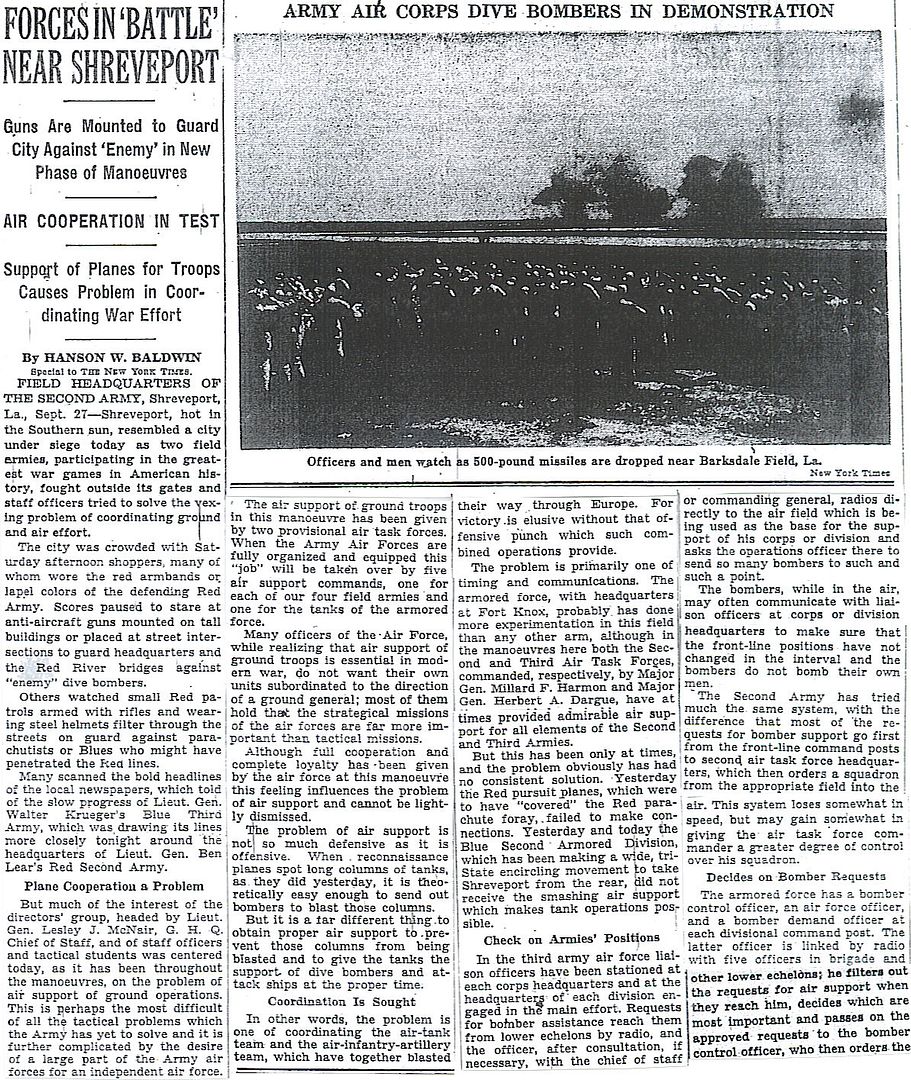
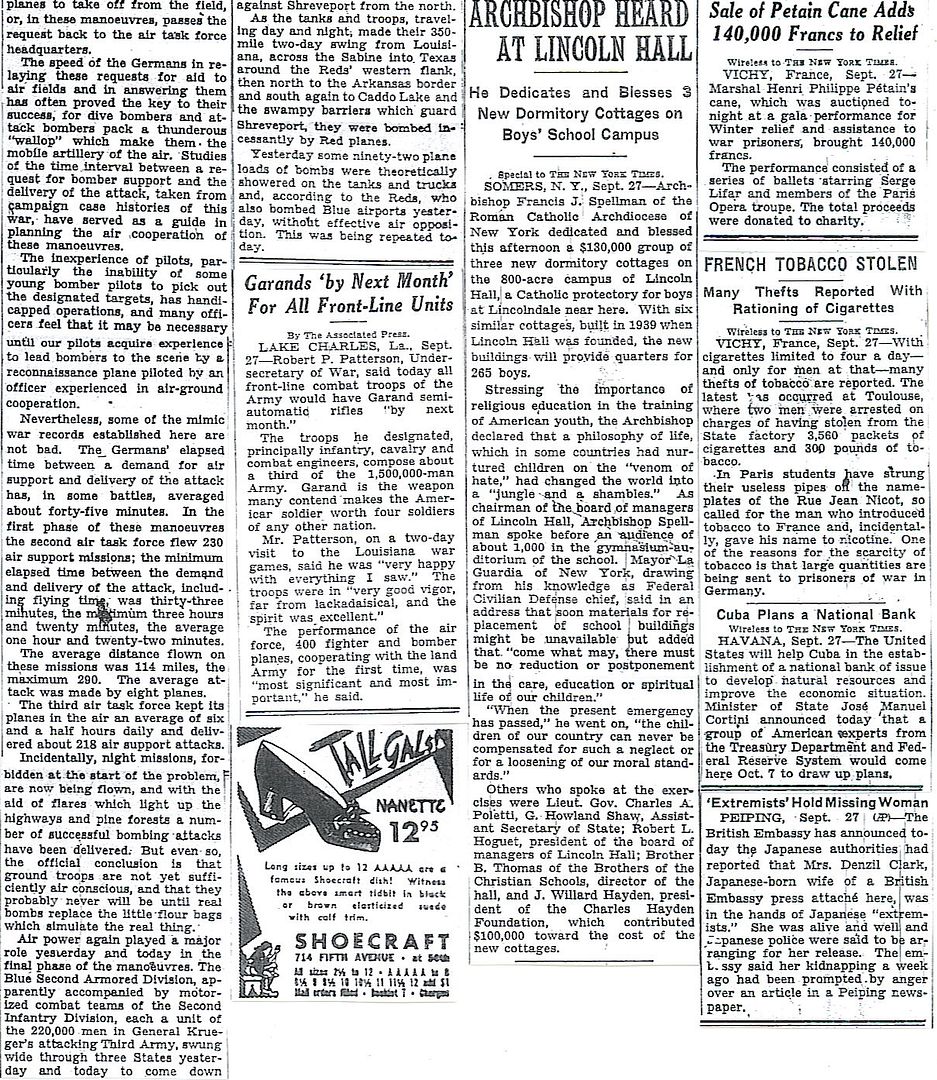
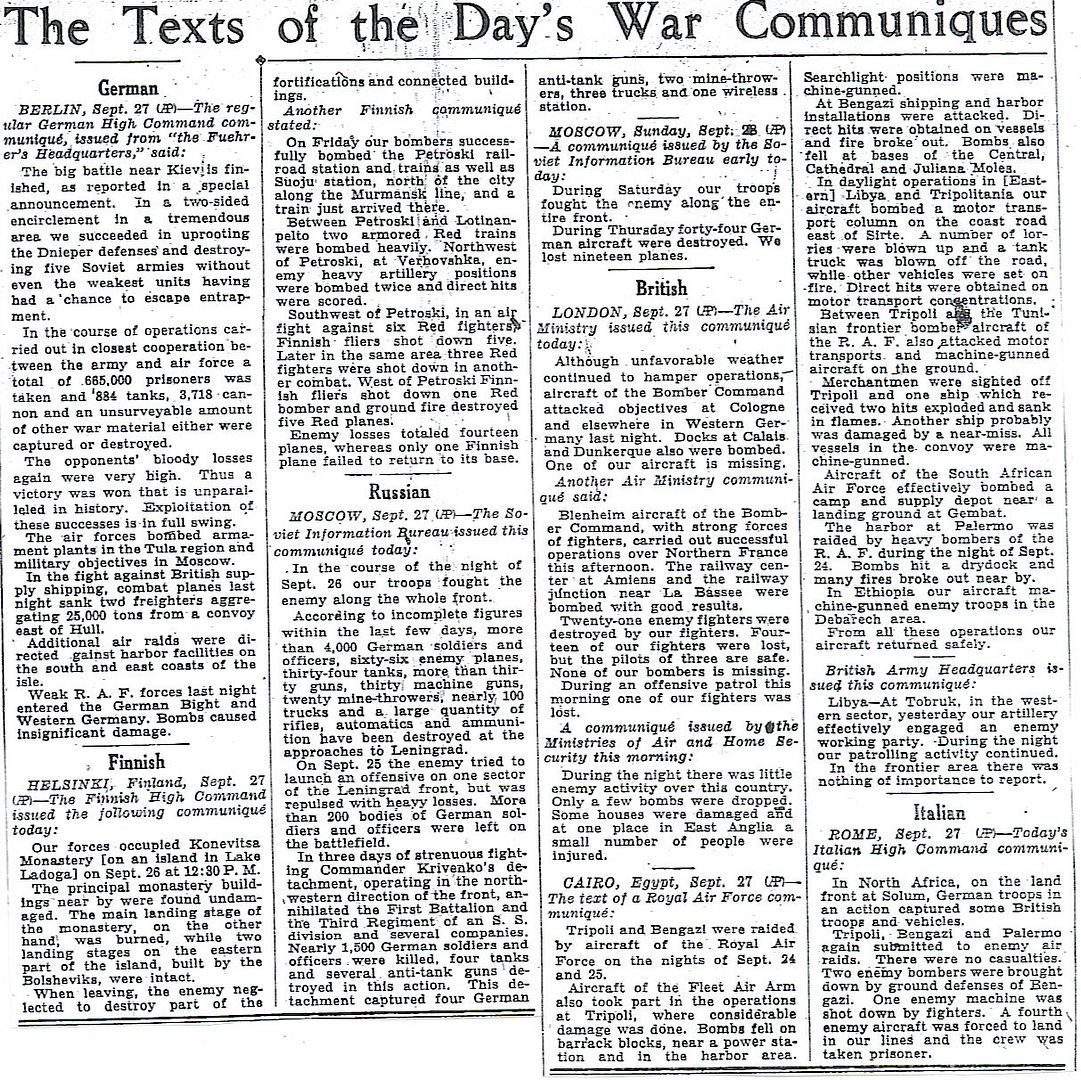
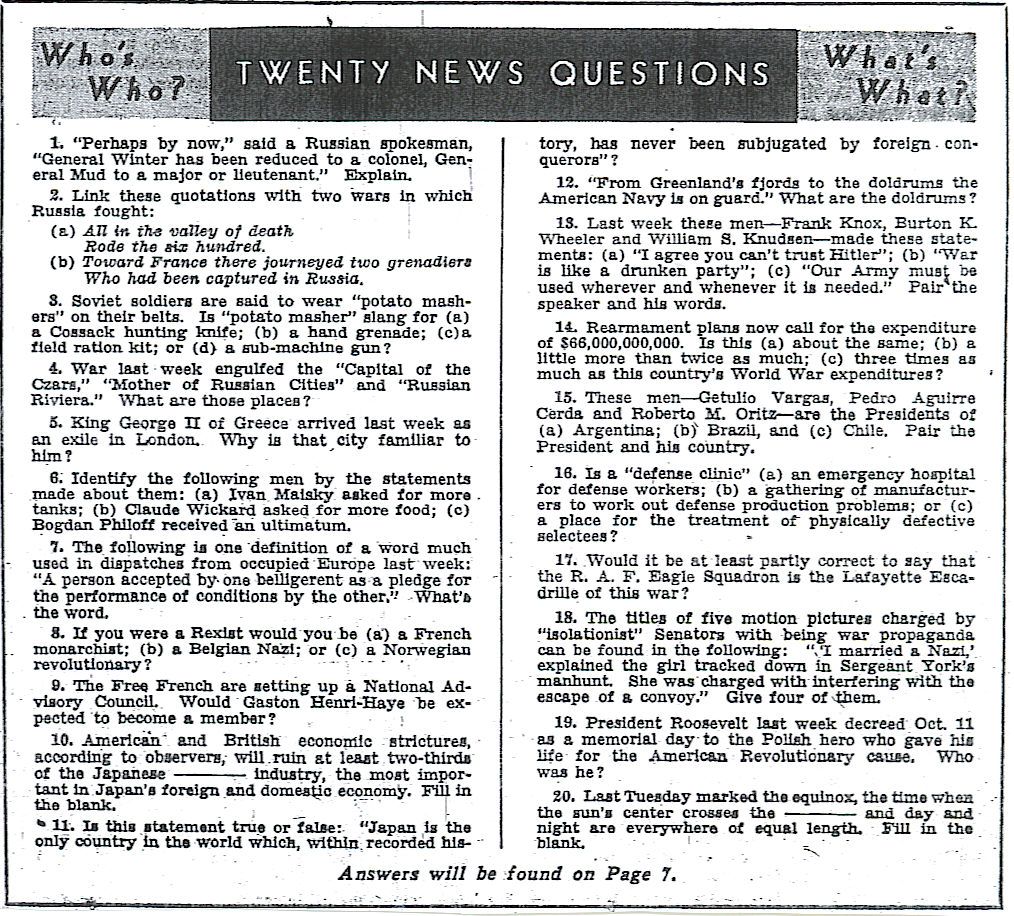
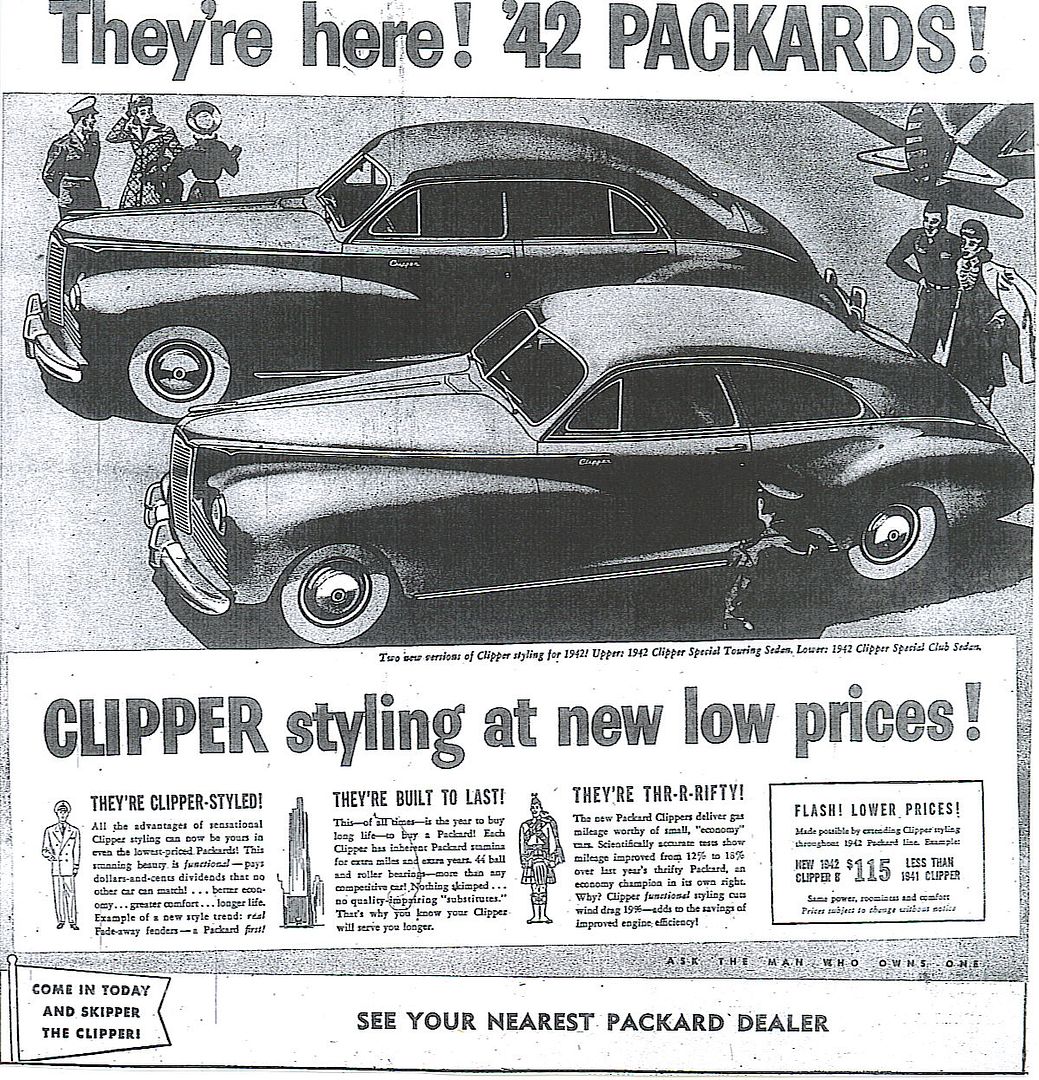
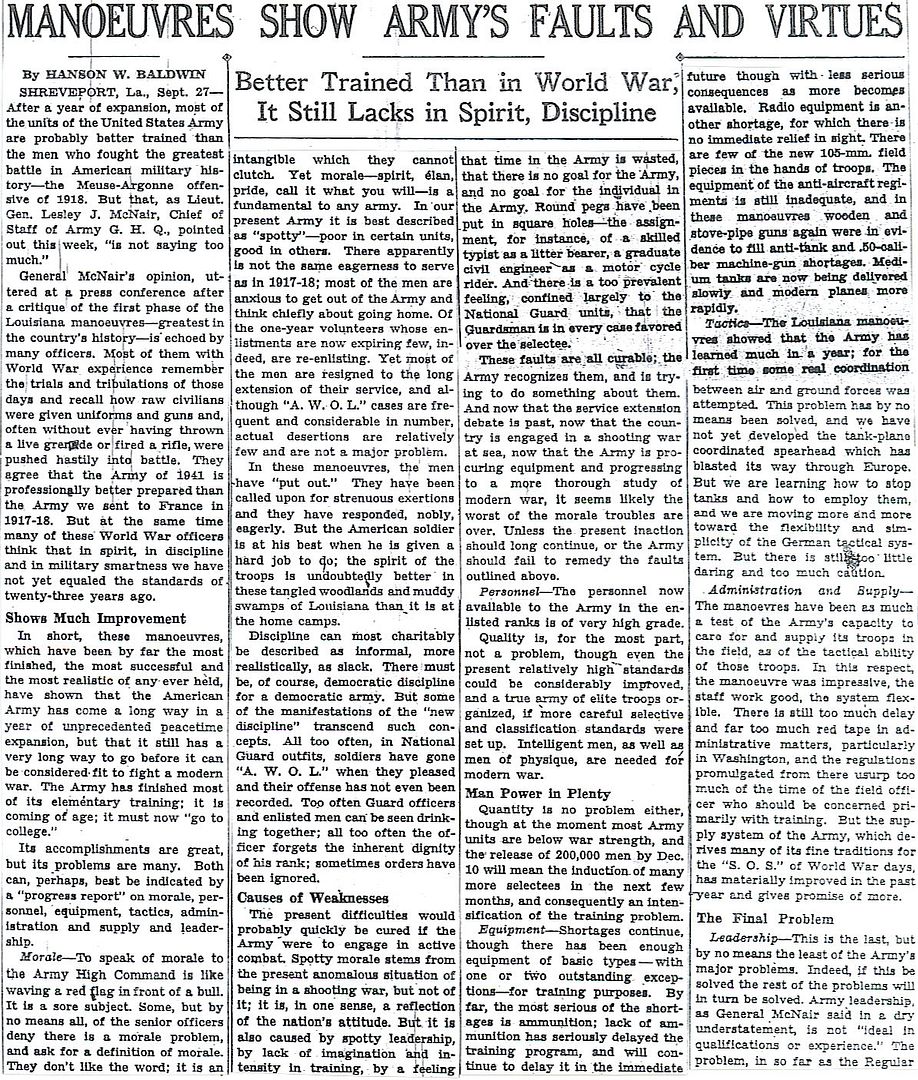
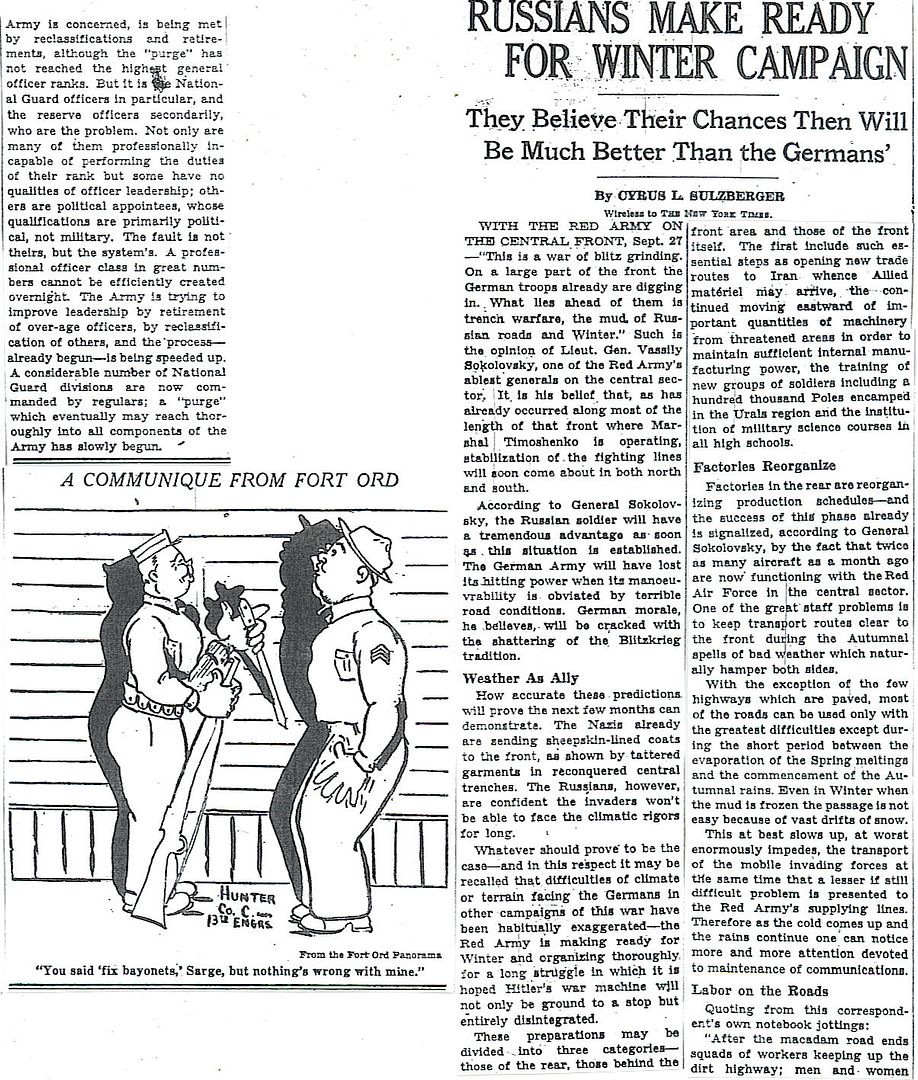
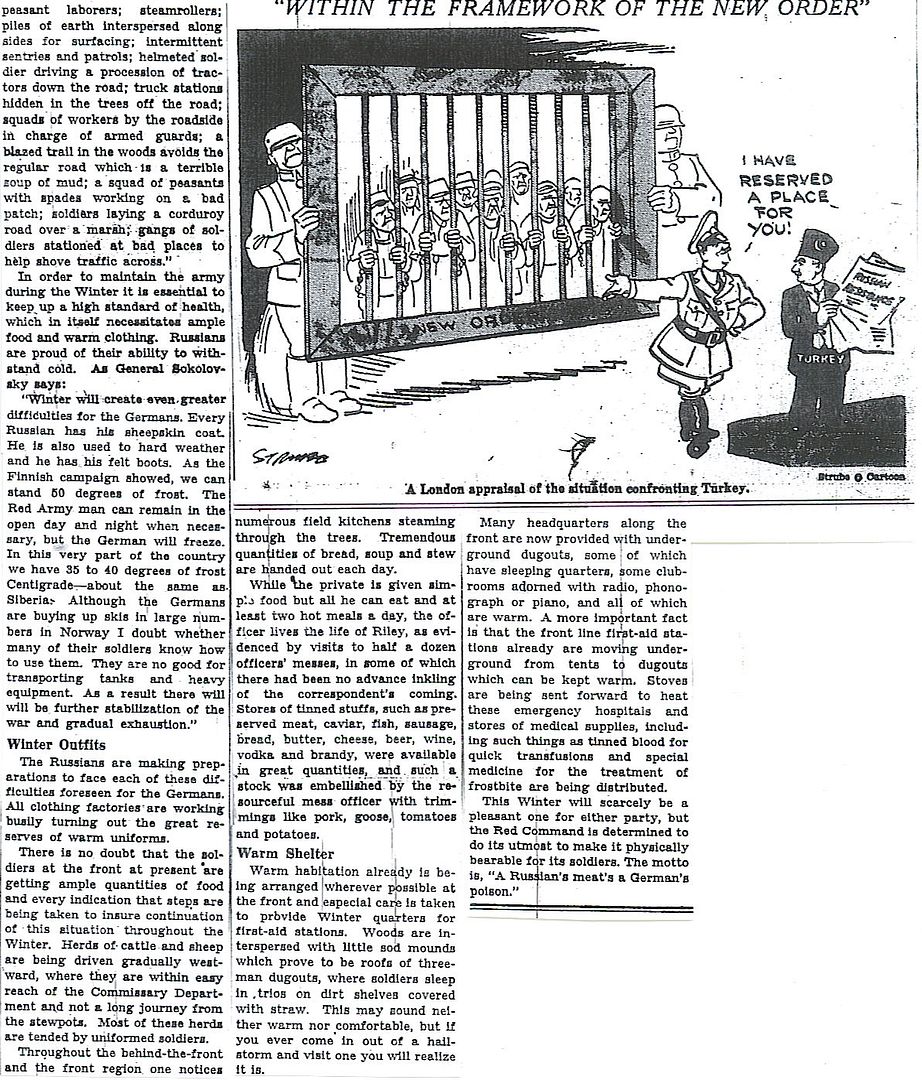
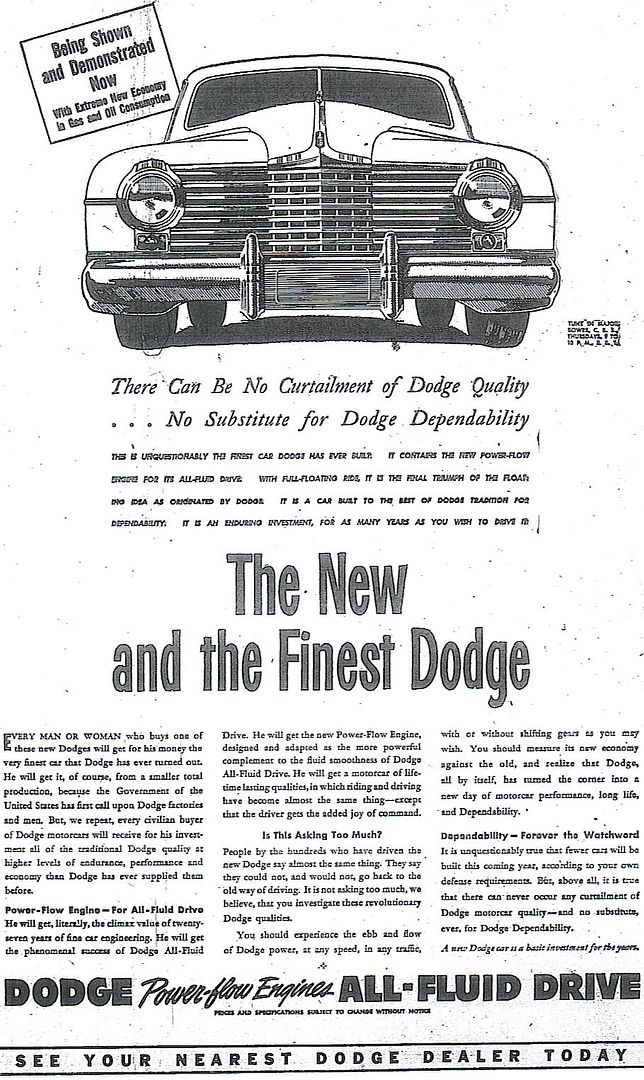
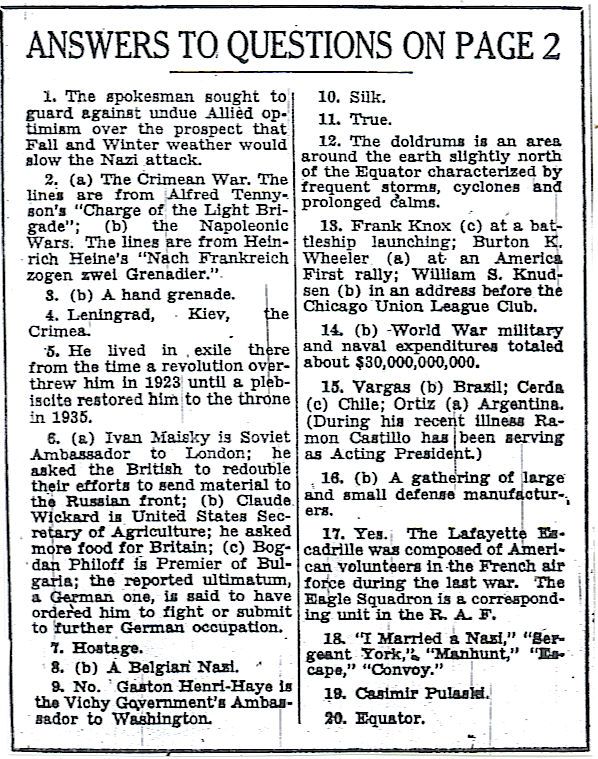
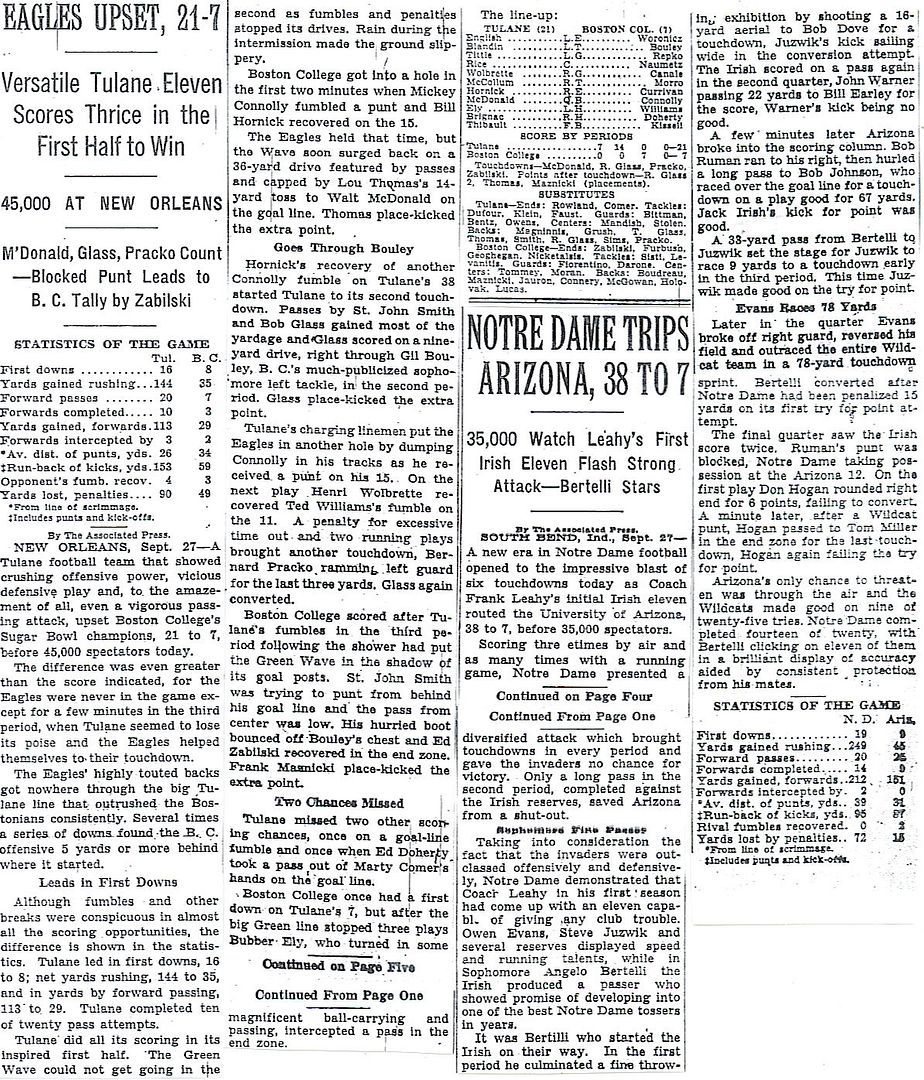
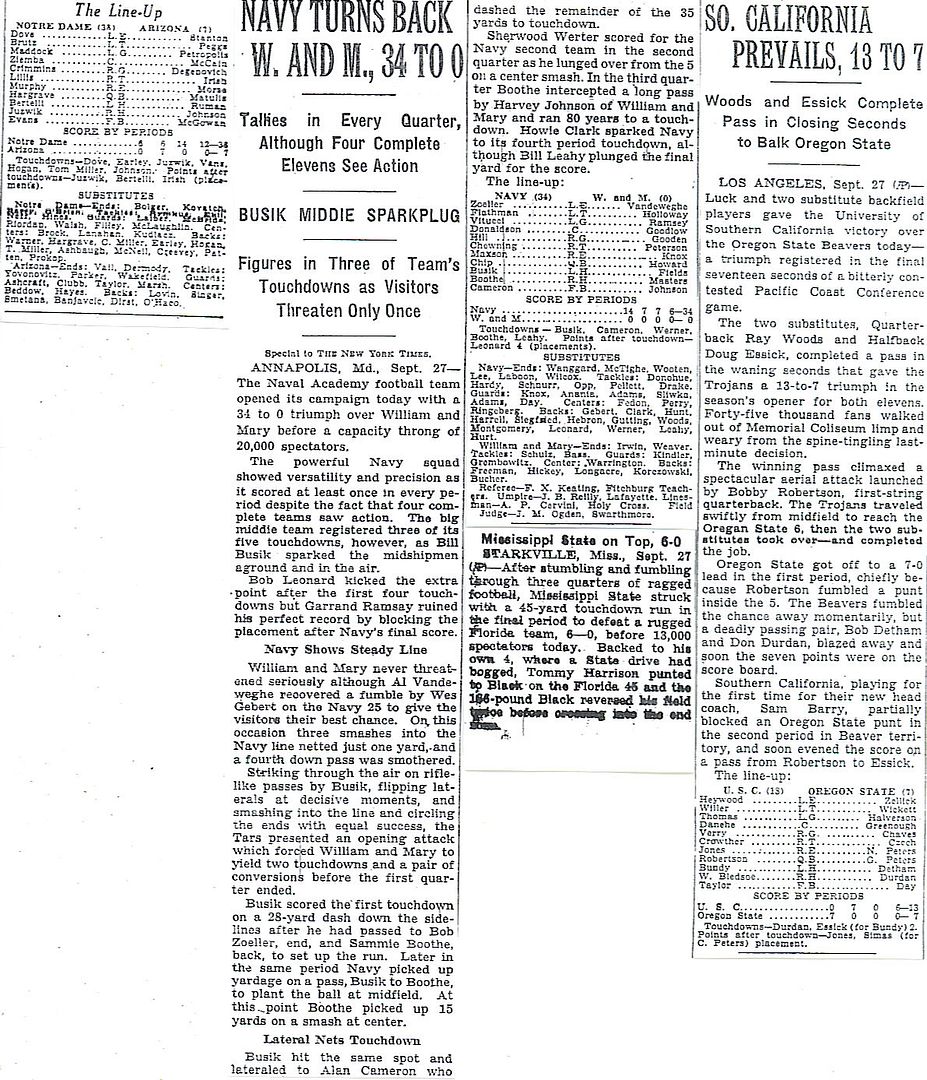
The News of the Week in Review
Twenty News Questions – 11
Manoeuvres Show Army’s Faults and Virtues – 13-14
Russians Make Ready for Winter Campaign – 14-15
Answers to Twenty News Questions – 17
Sports – Selected College Football Results
[Boston College] Eagles Upset, 21-7 – 18
Notre Dame Trips Arizona, 38 to 7 – 18-19
Navy Turns Back W. and M., 34 to 0 – 19
Mississippi on Top [of Florida], 6-0 – 19
So. California Prevails [over Oregon State], 13 to 7 - 19
The News of the Week in Review
Twenty News Questions – 11
Manoeuvres Show Army’s Faults and Virtues – 13-14
Russians Make Ready for Winter Campaign – 14-15
Answers to Twenty News Questions – 17
Sports – Selected College Football Results
[Boston College] Eagles Upset, 21-7 – 18
Notre Dame Trips Arizona, 38 to 7 – 18-19
Navy Turns Back W. and M., 34 to 0 – 19
Mississippi on Top [of Florida], 6-0 – 19
So. California Prevails [over Oregon State], 13 to 7 - 19
Sorry for the double ping. There is only one thread today.
http://www.onwar.com/chrono/1941/sep41/f28sep41.htm
Allies make plans in Moscow
Sunday, September 28, 1941 www.onwar.com
In Moscow... An Allied planning conference begins. Harriman attends from the US, Beaverbrook, from Britain and Molotov heads the Soviet delegation.
“Forces in ‘Battle’ Near Shreveport – 8-9”
For any one interested in the maneuvers mentioned, which are the largest maneuvers in US Army history with at least two Corps per side, I recommend this book:
http://www.amazon.com/U-S-Army-GHQ-Maneuvers-1941/dp/075671964X
The Army was able to get badly needed experience in large scale movement. A number of divisional commanders (particularly National Guard) were relieved and replaced with younger officers for lack of performance. This was very controversial, particularly for long serving guard officers who were replaced by regulars.
The maneuvers also show how much more work was needed to bring the Army up to speed. Unfortunately, time was something they did not have.
I didn’t do too well on the news quiz, earning a “C.”. I answered 22 of the 31 questions correctly.
30th September 1941—Some 300 miles south of Moscow, near Glukhov, in the Northern Ukraine, Second Lieutenant Lohse, commanding 1st Company, 3rd Rifle Regiment, raised his hand in his armored car and gave the command: "Forward!"
And just as the spearhead of the 3rd Panzer Division moved off towards the east at Glukhov, along with it the 4th Panzer Division, the 10th Motorized Infantry Division, and the whole XXIV Panzer Corps moved into action.
To the left was General Lemelsen's XLVII Panzer Corps with 17th and 18th Panzer Divisions and 29th Motorized Infantry Division.
Behind was General Kempf's XLVIII Panzer Corps, another two Infantry Corps with six divisions, and the 1st Cavalry Division for subsequent flank protection. Thus the Second Panzer Group was moving towards the north again in a broad wedge aimed at Moscow.
Operation Typhoon had begun—"the last battle of the year for the annihilation of the enemy," as Hitler had put it.
Colonel-General Guderian had been given a three-day lead so that he could play his part in the great offensive at the right moment and at the right spot.
It was a bold and carefully calculated plan, designed to outmaneuver Stalin's strong defensive forces before Moscow. It was perhaps the most precise battle plan of the whole war, and was now running like clockwork.
"Fast Heinz" Guderian lived up to his nickname when he moved out on September 30, two days before the rest of Army Group Center. Outside the ancient Ukrainian capital of Glukhov he hit the unprepared Operational Group Ermakov and scattered its five divisions, soon creating a 13-mile gap between him and the Soviet 13th Army.
The Soviet High Command had clearly not expected Guderian to pivot north again after the punishing Kiev fighting – so their attention was now focused on the Ukraine - and Group Ermakov had been ordered to launch spoiling attacks against Guderian’s extended flank. The five divisions in Major General’s Arkadii Ermakov’s operational group (three infantry, two cavalry and two tank brigades) had not dug in their troops or artillery. Soviet tactical intelligence at this point was very poor and they somehow totally missed the redeployment and reorganization of Guderian's armor.
Ermakov rallied his forces to counterattack a day later, but did not have much impact because of the usual failings: poor co-ordination, too few tanks and no air support.
However, by nightfall 3rd Panzer Division had its first experience with Katyusha rockets, dogs trained to run under tanks with explosives fixed to their backs, and almost undetectable wooden-cased, antitank mines.
Despite the heavy deployment of Guderian's 2nd Panzer Group in the Kiev encirclement, von Bock decided to use this highly experienced but nearly exhausted formation for the main effort on the drive to Moscow.
Guderian had to hustle to get his worn out and dispersed forces into their jumping-off positions on time although he was not entirely successful. A Soviet spoiling attack required Guderian to commit XIVIII Panzer Corps to screen his right flank around Putivl and consequently, he would begin his offensive with only XXIV and XLVII Panzer Corps. Guderian's left flank was virtually in the air, with the 1st Cavalry Division screening a 60km wide sector between his Panzer Group and von Weichs' Second (Infantry) Army.
This modern battle of Cannae was intended to unroll in two phases.
Phase one was to open with a break-through along the Soviet " Western Front " where it was held by the Ninth and Fourth Armies, to the north and south of the Smolensk-Moscow motor highway. Two Panzer groups were to race through the gap—Third Panzer Group forming the northern and Fourth Panzer Group the southern jaw of the pincer movement. These jaws were to close on the highway near Vyazma, thereby surrounding the enemy forces outside the immediate defenses of the city. Simultaneously, Guderian's Panzer Corps was to strike towards Orel from the south-west, from the Glukhov area in the Northern Ukraine. After driving deep into the rear of Yeremenko's forces the Corps would wheel towards Bryansk. Three Soviet Armies would thus be encircled.
Phase two of the operation then envisaged the pursuit of all escaping enemy forces along a broad front by all three Panzer Groups; this to be followed by a drive to Moscow, with either the capture or the encirclement of the city.
It was a considerable force that was moving into battle under Field-Marshal von Bock—three infantry Armies (the Ninth, the Fourth, and the Second), the two Panzer Groups of the Central Front (Guderian's Second and Hoth's Third), to which was now added Hoepner's Fourth Panzer Group, which had been switched down from the Leningrad front and was now in charge of the right jaw of the pincers along the Smolensk-Moscow highway, while its LVI Panzer Corps was stiffening the left wing of Hoth's Panzer Group.
In this manner fourteen Panzer divisions, eight motorized divisions, and two motorized brigades, as well as forty-six infantry divisions, had been brought together for the operation. The offensive was supported by two Air Fleets. Strong anti-aircraft units had been assigned to the Armies.
Everything was magnificently planned. Only the weather could not be foreseen. Would it hold? Or would the autumn mud set in before the troops reached Moscow?
Moltke had written in 1864: "An operation cannot be based on the weather, but it can be based on the season."
But the favorable season on which the operation should have been based was over. Winter was around the corner. Nevertheless Hitler risked the venture. On the morning of 30th September the crash of tank cannon and anti-tank guns ushered in the double battle of Vyazma and Bryansk, the Cannae of the Second World War, the most perfect battle of encirclement in military history.
Guderian began his offensive at 0635hrs on 30 September, with his two panzer corps striking the unsuspecting Soviets.
Two 210mm howitzer battalions provided an artillery preparation and Luftwaffe close air support hit the Soviet lines of communication hard.
The main Schwerpunkt, Kampfgruppe Eberbach of 4th Panzer Division, attacked the newly raised 283rd Rifle Division and inexperienced 150th Tank Brigade in the flat terrain near Essman. On the flanks of the Schwerpunkt, 3rd Panzer Division dispersed the 121st Tank Brigade and the 10 Motorized Infantry Division attempted to pin down the two cavalry divisions of Group Ermakov. Due to poor communications and limited reconnaissance capabilities, Ermakov thought his group was being attacked by only a single German corps and sent this faulty information to the front commander, Lieutenant General Yeremenko.
Based upon Ermakov’s inaccurate reporting, Yeremenko assessed Guderian's attack to be a diversion and decided not to commit any substantial reserves to this area. Instead. Ermakov was ordered to launch a local counterattack to repulse the German penetration but a puny and uncoordinated counterattack by 30 light tanks near Sevsk on 1 October only resulted in the destruction of Ermakov’s remaining armor. One Panzer company even managed to overrun a regiment of 122mm howitzers, which was caught in the open. Eberbach's panzers seized Sevsk at noon on 1 October, completing the breakthrough of the Soviet Bryansk front’s left flank. Without a prepared defense, Ermakov’s divisions fell back in disorder toward Orel and Bryansk, thereby uncovering the flank of the Soviet 13th Army on their right flank. .
To return to the battle. One might have expected that Guderian's offensive on the Bryansk flank would encounter a well prepared opponent and therefore stiff resistance. After all, General Yeremenko had begun building up his famous front as early as 12th August, immediately after his conversation with Stalin, when an attack seemed imminent, and he had been reinforcing it ever since.
To the day he died Marshal Yeremenko maintained in his memoirs that at the end of August, Guderian could never have broken through his defensive front, and that his drive to the south, to Kiev, had essentially been a second-best choice.
For the fox Guderian the grapes of Moscow had hung too high: that was why he had gone to Kiev instead.
Strangely enough, they were now, six weeks later, very much within his reach. Boldly and unconcernedly Guderian reached out for them by his drive to Bryansk, the important rail and road junction.
Even at the time of Guderian's drive into the Ukraine, in August, the town of Bryansk had been a kind of mysterious and sinister threat in his flank. It was known, from the evidence of prisoners, that General Yeremenko and his staff resided there, together with special contingents and crack units.
It was known that the town was a key point in the Soviet defense of Moscow. It lay embedded in thick forests, protected by swampy lowlands. From it attacks were launched repeatedly against Guderian's exposed flank.
And now that the decisive blow at Moscow was beginning to take shape from the Roslavl-Smolensk area, Bryansk and the Soviet armies in its vicinity again represented a grave threat to Guderian's flank. To remove this threat was as much a prerequisite for the main attack on Moscow as was the liquidation of the strong covering forces in the Vyazma area.
That was the tactical meaning of the double battle of Vyazma and Bryansk.
To every one's surprise Guderian's attack against Yeremenko's defensive front succeeded at the first attempt.
The breakthrough was accomplished in the area of the Soviet Thirteenth Army.
It was fine autumn weather. The roads in the area of Second Panzer Group were still dry.
The spearhead of XXIV PanzerCorps, the 4th Panzer Division, raced ahead as if the devil were at their heels.
As he was chasing after his advanced detachment—already being led against Dmitrovsk-Orlovskiy by Major von Jungenfeldt—Guderian met the Corps commander and the commander of 4th Panzer Division, Generals Freiherr Geyr von Schweppenburg and Freiherr von Langermann-Erlenkamp. The great question was: should the advance be continued in order to knock out completely the Soviet Thirteenth Army, which was already in confusion, or should the troops be halted and given time to re-form and stock up with fuel?
Both generals counseled caution: they had been getting reports that fuel was running short and that the men were tired out.
A little later, near the windmill hill of Sevsk, Guderian met Colonel Eberbach, the commander of the Panzer brigade.
" I hear you're forced to halt, Eberbach," said Guderian.
" Halt, Herr Generaloberst?" the colonel asked in surprise. He added drily: " We're just going nicely, and it would be a mistake to halt now."
" But what about the juice, Eberbach? I'm told you're running out."
Eberbach laughed.
" We're running on the juice that hasn't been reported to Battalion." Guderian, who knew his men, joined in the laughter. " All right, carry on," he said.
That day the tanks of 4th Panzer Division covered 80 miles, fighting all the way.
The Soviet Thirteenth Army was completely dislodged.
What Yeremenko had thought impossible happened: the town of Orel, a city of 110,000 people, which was only 12 miles behind the Bryansk front, was taken by Eberbach's tanks at noon on 3rd October. The pickets outside the town were taken so much by surprise that they did not fire a single round. The first vehicle the German tanks encountered was a trolley full of people. The passengers clearly thought that Soviet troops were moving into the town and waved delightedly.
Things were now going badly for Yeremenko's Bryansk front.
The 17th and 18th Panzer Divisions of XLVII Panzer Corps wheeled towards Karachev and cut the Bryansk-Orel road behind Yeremenko's headquarters. On 5th October the 18th Panzer Division took Karachev.
The trap was closing.
Yeremenko saw the impending disaster. He telephoned the Kremlin and asked for permission to break out. But Shaposhnikov, the Chief of General Staff, put him off. He urged him to wait a little longer.
Yeremenko waited.
But Guderian's armored spearheads did not.
With an advanced detachment of the reinforced 39th Panzer Regiment Major Gradl struck towards Bryansk from Karachev —that is, from behind, 30 miles past Yeremenko's headquarters. And on 6th October General von Arnim's 17th Panzer Division did what not even the greatest optimist would have considered possible: they took the town of Bryansk and the bridge over the Desna by a swift coup. Bryansk was taken.
The town, crammed full with troops, heavy artillery, and secret police units had quite simply fallen in their laps.
In vain were 100,000 Molotov cocktails lying in the stores. In vain had the strict order been issued: not a single house to be surrendered without opposition. One of the most important railway junctions of European Russia was in German hands.
The link-up between Guderian's Second Panzer Group and the Second Army, which was coming up from the west, had been accomplished. Around Karachev and north of it the 18th Panzer Division and, subordinated to it, the " Grossdeutschland " Motorized Infantry Regiment were providing cover. Farther south, to both sides of Dobrik, the 29th Motorized Infantry Division was covering the Corps' flanks. The trap had been closed behind three Soviet Armies—the Third, the Thirteenth, and the Fiftieth. The date was 6th October
During the following night the first snow fell.
For a few hours the vast landscape was shrouded in white. In the morning it thawed again.
The roads were turned into bottomless quagmires. The great highways became skid-pans. "General Mud" took over. But he was too late to save Stalin's armies in the Vyazma—Bryansk area. Entire infantry divisions were detailed for road-clearing. They worked like men possessed in order to keep the advance going.
As usual, there was disagreement.
Von Bock wanted a deeper encirclement east of Vyazma, while OKH favored a shallower one aimed at that city. After closing the pockets Halder wanted to send the motorized units into Moscow, but Hitler wanted no part of urban combat, as he had made clear earlier at Kiev and Leningrad. Also, attempts to co-ordinate with an attack by Von Leeb toward Lake Ilmen with Sixteenth Army, and with a movement by Von Rundstedt on Kharkov with Sixth Army, met with mixed results.
Within 24 hours Von Kluge began to interfere by ordering Hoepner, 50 miles into the Soviet rear, to redirect XLVI Panzer Corps northward in order to create a smaller encirclement west of Vyazma - yet another dangerous dispersion of armor that was intended to be employed in mass.
The bulk of Fourth Panzer Group raced up the road toward Yukhnov, including 5th Panzer Division (new to the theater, and originally earmarked for Africa, so many of its vehicles still wore their desert paint scheme) Soviet fighter pilots reported this movement, but Marshal Shaposhnikov demanded repeated confirmation, and by the time he received it the town had already fallen.
For a few hours the vast landscape was shrouded in white. In the morning it thawed again. The roads were turned into bottomless quagmires. The great highways became skid-pans.
"General Mud" took over. But he was too late to save Stalin's armies in the Vyazma—Bryansk area. Entire infantry divisions were detailed for road-clearing. They worked like men possessed in order to keep the advance going.
Farther north, along the Smolensk-Moscow highway, the offensive had likewise started successfully. Hoepner's Fourth Panzer Group sluiced three Panzer Corps—XL, XLVI, and LVII Corps—through the Soviet front south of the highway at Roslavl behind the 2nd Panzer Division. They fanned out and with their left wing thrust northward in the direction of the motor highway.
On 6th October the spearhead of 10th Panzer Division was only 11 miles south-east of Vyazma, skirmishing with retreating Soviet units. The battle of Vyazma had reached its peak.
During the night there was a succession of Soviet attempts to break out of the ring.
At nightfall the whole vast forest area seemed to come to life. Firing came from everywhere. Ammunition was blowing up. Ricks of straw were blazing. Signal flares eerily lit up the scene for a few seconds. The area swarmed with Red Army soldiers who had lost their units.
The advance command post of XL Panzer Corps had to fight for their lives. Where was the front line? Who was surrounding whom? When the long night at last drew to its end a Soviet cavalry squadron tried to break through in the grey light of dawn of 7th October. Behind it came a convoy of lorries carrying Red Army women. Machine-gun positions of 2nd Panzer Division foiled the attempted breakout.
It was a painful and sickening picture—horses and their riders collapsing and dying under the bursts of machine-gun fire
to be continued
The USC Trojans scored an impressive win at the Coliseum to open the season. but we face a tremendous challenge next week when the Ohio State Buckeyes come to town. The Buckeyes will be hungry, never having beaten the Trojans—they lost the first two games between the schools back in ‘37 and ‘38, so our new coach and his young team will be in for a fight.
Fight on!
You're going to mess up the curve for the rest of us. Until now anything over 50% is at least a B-.
Now we see the total number of prisoners bagged at Kiev. And there will be just about as many bagged in the encirclements in the opening phases of Operation Typhoon.
The Soviet Southwestern Front exists in name only right now, as the German forces under Rundstedt are marching at will across eastern Ukraine. Timoshenko’s forces were depleted in the heavy fighting at Yelnia, and we’ll see how Typhoon goes in the coming days. As Cougar noted a few days ago, the Germans will bag literally millions of Soviet POW’s during this phase of the war, and most of them will starve to death or die of exposure. The German general staff figures that with such staggering losses the Soviet Union must be on the point of military collapse. Yet as soon as one group of armies is destroyed, another group is conjured up to take it’s place. This saves the USSR, and credit is due to a relatively unknown Soviet military leader, Marshall Boris Shaposhnikov. He created and implemented the mobilization plan that enabled the USSR to continuously pump new men into shattered formations, and create new ones almost overnight. Shaposhnikov had seen to it that in the 1930s, just about every Soviet male under the age of 50 had some military training, and this huge manpower pool allowed him to keep the stream of fresh bodies flowing to the battlefront. Even though they had some training, you couldn’t really call them well-trained. They were certainly indifferently equipped, and not very well led; more a mob than an army. But, they were there and the Germans had to fight them.
Sulzberger’s article based on his interview with Sokolovsky is quite revealing. It’s open knowledge, printed right there in the New York Times, that the Russian road network is about to become unusable. The Russian word for this time of year is “Rasputitsa” or “Roadless season.” They expect that the front will stabilize once the roads turn to mud. And then comes the winter.
Let’s see what the Germans decide to do.
Am I the only one who is getting a kick out of how absolutely Wilsonian this is. I bet had the Japanese not attacked the U.S., this would eventually had become pretext for war and the similarities between the U.S. entry in WWII and the Great War would be stunning.
Doenitz realized that we were already de facto at war with Germany. This was the one time where German armed forces were being attacked and Hitler was backing down from further provocation. I don’t think that happened any other time (usually because Hitler was the provocateur.) Unlike Doenitz, he wasn’t begging for war with us, and really didn’t want to fight us. That steadily shrinking rational part of his mind knew he already had his hands full with the British Empire and Soviet Union.
Once Japan is at war with us, I guess he just figured he was going to war with us sooner or later so might as well get it on.
Those who say FDR deliberately got us into a war are correct when it comes to Germany. On Japan, I’m not so sure, but my opinion tends toward FDR provoking them, too. There may have been some expectation that the Japanese might have backed down. Now, the real question is: If Japan had only chosen to attack British and Dutch possessions in the Far East, would we have declared war on Japan? That’s unclear. I do know that’s pretty much an academic question only; if the Japanese were going to attack the NEI and Malaya, they could not risk an American presence in the Philippines athwart their communications lines. They had to attack the Philippines as well.
And that, by the way, is the Japanese attack that FDR and the United States military were expecting.
That is is exactly what the Japanese should have done. The US would not have declared war because of a Japanese invasion of Malaya. The B-17's in the Philippines might have seemed a threat, but time would tell that they were no threat to ships.
Certainly by now we are only at peace with Germany on paper. What I find striking is the parallels between some of FDR’s responses and the responses of Woodrow Wilson in the lead up to America’s entry into World War I. In some respects I guess it shouldn’t be a surprise since FDR was Assistant Secretary of the Navy under Wilson, and could be considered a “Wilson Democrat”.
FDR’s frequent and recently amplified calls for freedom of the seas are almost carbon copy of some of the positions Wilson took while America was still maintaining its neutrality. While many look at the USS Lusitania as the catalyst for America’s entry into the war, it really was only a minor part and more of a propaganda piece than something that drove policy. That’s why almost two years past between the Lusitania and America’s declaration. It was the 1917 decision of Germany to conduct unrestricted submarine warfare that was a major motivator for America to enter the fray. The escalation of German aggression in the Atlantic and the threat to safe shipping was the driving factor in the end.
Without Japan, this escalation and response by FDR would mimic Wilson’s very closely. Was FDR trying to provoke Germany? Absolutely. This is probably the only major difference between FDR and Wilson and it probably is more attributed to “lesson’s learned” and the nature of the new Nazi enemy than anything else.
Japan, meanwhile, isn’t doing itself any favors at this point. At at time when the failure of appeasement has been accepted, by the remaining western powers, they escalate their program of aggression in the Asian theater. This is why the U.S. policy towards Japan doesn’t shock me. Appeasement didn’t work, so the next logical step would be economic warfare to try and stem Japanese aggression.
Was it really about “freedom of the seas?” Or was it something else? I could see the academic idealist Wilson putting seeing a noble idea of “freedom of the seas” as the centerpiece of his policy, but FDR was more of a pragmatist. And Wilson had to be somewhat pragmatic, too.
The other factor wasn’t freedom of the seas, but freedom of Britain to repay war debt. From my reading of Strachan’s “The First World War” I’m convinced that by 1917, we were financially beholden to an Allied victory. The only place in the world with enough financial credit to back the staggering costs of the war was the New York bond market. The British bundled the French and Russian war credits along with their own and sold the debt on the New York market. It made good business sense as a lot of that money was going into the American economy for war goods. It also made sense because the US needed that “stimulus” to recover from a nasty and prolonged depression in 1913. It was a classic case of “owe the bank $10,000 and the bank owns you; owe the bank $100,000,000 and you own the bank.” Your parallels in WWII are that although the British no longer have the same economic clout as in 1915, and aren’t bundling French and Russian bonds with theirs, they are still a big debtor to the US. And with Lend-Lease, they are now being directly supported by the US taxpayer. Uncle Sam needs to safeguard his investment. And yes, my British friends assure me that the British repaid every dollar of Lend-Lease through some time in the 1960s, which in part led to the prolonged economic malaise that afflicted Britain after the war.
The Germans, on the other hand, had been frozen out of the New York bond market in 1941 just as much as they had been in 1915, maybe more so. In WW1, it made no sense for US bankers to sell bonds to the Germans. With the Royal Navy sealing off the Central Powers, the Germans weren’t in position to take the war credits and “Buy American.” So there was no financial interest in a German victory; in fact, American finance had bet against them. So the Germans sold their war debt to themselves, usually in the form of short 5 year notes. The result for Germany was the Weimar turbo-inflation of the early 1920’s; all those notes matured, but nobody wanted to buy them. The signs of this inflation were appearing in the German economy as early as 1917.
An interesting sidelight: this chapter from Strachan’s book taught me much about our current fiscal and economic situation. Up to 2008, our government followed the British model of financing our debt; we sold our bonds on the international market to the Chinese, Saudis and Japanese. When the annual deficits were $400 billion or less, there was enough capital available on the world markets to soak it up. And those countries had a stake in keeping the American economy going. When the democrats and 0bama quadrupled that annual deficit, the amount of that deficit far exceeded the capacity of the world markets to finance it. There just isn’t that much money in the world. So the Fed had to resort to QEI, QEII, and is now talking about QEIII. Forget why they say they are making the money available; the amounts of each QE happen to be roughly equivalent to the amount of the deficits less the amounts of Treasury Notes sold. We are papering over our debt by monetizing it. In other words, we have moved from the British model to the German model.
The only saving grace is that the Fed realized where they were headed, and the recent announcement of trading off the notes for longer-term securities is just a way of trying to head off the turbo-inflation.
If the world were a chessboard, yes, it made sense to do an end-run around the Philippines and leave America alone. But the world is full of doubt as to the intentions and reactions of others. If I am a Japanese strategist, looking at the USA’s increasingly provocative stance against Japan, as well as it’s de facto military alliance with Britain against Germany, I’d probably come to the conclusion that an attack on Malaya brings the United States into a war as well.
Going with their overall philosophy of “hit back first” that means you are attacking the USA too.
That’s some interesting information on the monetary side of the issue. I would have to say with that degree of vestment, it would also have to be a major consideration much like the issue of the unrestricted submarine warfare issue. In some respects the two are linked together since the supply side of the economic issue is reliant on the ability to safely ship materials to Europe. So I would say that “freedom of the seas” is a major aspect of the Wilsonian position on the war, but at the same time, I couldn’t say it was the sole one.
Right now I’m working on a logistical analysis of the transportation of the AEF to Europe in World War I and one major component of my research is on the fiscal policy or economics of the war. If you want another book on the subject, and by the way I think I will go look up Strachan’s work, I recommend “The Economics of World War I” edited by Stepen Broadberry and Mark Harrison. It is a compilation of different economic writings for several of the participants in the First World War. It’s very fact heavy which I know you don’t mind but it covers all sides (Germany, Austria-Hungary, Ottoman, Dutch, France, UK, Russia, Italy, and the U.S.)
Interesting side note on unrestricted submarine warfare issue. This policy was the final catalyst that allowed China to join the Allies and declare war on Germany and Austria-Hungary. China had actually tried to join the Allies two time prior to this event only to be spurned by the Allies (mostly the Japanese and the British). They had several motivations for wanting to join the war with a dominant one being the possibilities of reclaiming the Shandong province which had been placed in Germany’s sphere of influence in 1897. Their first attempt to join the war was defeated mostly by Japan’s interventions and by November of 1914, Japan had invaded and occupied Shandong forcably taking it from the Germans and marking their only offensive action of the entire war.
When the United States, as a neutral nation broke diplomatic ties with Germany over the unrestricted submarine warfare policy, China used this (as a declared neutral) as a pretext to follow the American model and this quickly led to them finally declaring war on Germany in August of 1917.
Of course they never got Shandong back. Despite their efforts and the Paris peace conferences, they didn’t know that Japan and Britain had already signed a treaty in 1917 conceding the German holdings including occupied Shandong to Japan. So disgusted by this were the Chinese that they refused to sign the Treaty of Versailles.
http://homepage.ntlworld.com/andrew.etherington/month/thismonth/28.htm
September 28th, 1941
UNITED KINGDOM: Destroyer HMS Dulverton commissioned. (Dave Shirlaw)
CZECHOSLOVAKIA: German Governor Heydrich imposes martial law on 6 districts of Moravia and Bohemia.
U.S.S.R.: A conference in Moscow begins. Originally thought of at Placentia Bay in August, Harriman from the US; Beaverbrook for the UK and Molotov meet regarding Lend-Lease and British Aid to Russia. This conference will last through October 1st.
MALTA: The entire population of Malta seems to have crowded the shoreline to cheer as three cruisers - their bands playing and crews lined up as though they had been on a peacetime cruise - led a vitally needed convoy into the Grand Harbour of Valetta today.
Few convoys have had a such a powerful escort: three battleships - HMS NELSON, HMS RODNEY and HMS Prince of Wales - the carrier HMS ARK ROYAL, five cruisers and 18 destroyers. They were shepherding nine fast merchant ships, totalling 81,000 tons, with 2,600 troops divided among the transports and warships.
Three days out from Gibraltar the convoy, codenamed Operation Halberd, came under fierce air attack, with HMS ARK ROYAL’s fighters stretched to the limit. HMS NELSON was slowed down by a torpedo hit.
Despite reports that the Italian fleet had left port, no ship-to-ship encounters took place, although the convoy came under further torpedo attacks from the air with one transport, Imperial Star hit - but her troops were taken off before she sank.
MEDITERRANEAN SEA:Corvette HMS Hyacinth attacked Italian submarine Fisalia near Jaffa (Palestine).
At 2205hrs U-331 began her attempt to break through into the Mediterranean. Next morning at 0430hrs the boat had successfully completed the passage. (Dave Shirlaw)
NICARAGUA: Over 100 are killed as a hurricane strikes the Cabo Gracias area. (Jack McKillop)
U.S.A.: Baseball, Boston Red Sox left fielder Ted Williams is batting .399955 (.400 rounded) at the beginning of a double header with the Philadelphia Athletics at Shibe Park in Philadelphia on the final day of the regular season. In the first game, Williams goes 4-for-5 as the Red Sox defeat the A’s 12-11; this raises his batting average to .404. In the second game, Williams gets 2 hits in 3 times-at-bat and finishes the season with a .4057 (.406 rounded) batting average.
In Ebbets Field in Brooklyn, New York, the Brooklyn Dodgers meet the Philadelphia Phillies. The Dodgers win 6-1 and finish the season with a 100-54 record, 2-1/2 games ahead of the St. Louis Cardinals. The Dodgers set a new attendance record of 1,215,253. But the Dodgers must now meet the mighty New York Yankees in a “subway series.” (Jack McKillop)
Disclaimer: Opinions posted on Free Republic are those of the individual posters and do not necessarily represent the opinion of Free Republic or its management. All materials posted herein are protected by copyright law and the exemption for fair use of copyrighted works.